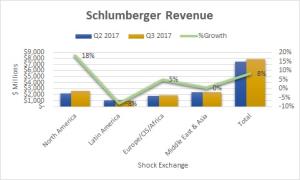The oil market never ceases to surprise. When oil was gushing in 2014 and then prices suddenly turned to the downside after the Fed began unwinding quantitative easing. When oil services firms seemed like they were on the ropes in 2016, suddenly prices spiked to give them new life. OPEC followed through on promised supply cuts in the second half of 2016, which buoyed markets further. Oil services giant Schlumberger (SLB) was firing on all cylinders for most of the year.
However, one of its cylinders – Latin America – appears to have misfired. The company’s Q3 revenue was up 8% sequentially, but Latin America was off 8%. That’s a sea change compared to Halliburton (HAL) who experienced 4% growth from Latin America last quarter.

Part of the decline was due to the completion of reservoir characterization and drilling activities in the Geomarket in Mexico and Central America. In the first half of 2016 Schlumberger curtailed operations in Venezuela due to slow payments from PDVSA, the state-owned oil company. The company helped PDVSA finance some of its oilfield services needs. At Q3 2017 it had a receivables balance of $0.5 billion and a promissory note of $0.2 billion with whom the company calls its “primary customer in Venezuela.”
According to Schlumberger’s recent 10-Q, it entered into a financing arrangement that involved the exchange of $700 million in outstanding accounts receivable for a three-year promissory note. Schlumberger recently recorded a $460 million loss on the note. In addition, the company reached an agreement to settle about $1 billion in past due receivables from Ecuador. Until certain Latin America customers improve their credit quality the company might reduce even more exposure to the region.
North America Land Drilling Might Have Peaked
North America land drilling has been white hot, and firms like Halliburton and Baker Hughes (BHI) with major exposure to the sector have benefited the most. Schlumberger receives about 33% of its revenue from North America. This quarter Schlumberger’s revenue from North America was up 18% sequentially as the company nearly employed its complete shale fracturing capacity for land drilling. Shale plays have taken advantage of rising oil prices driven by OPEC’s supply cut.











Leave A Comment